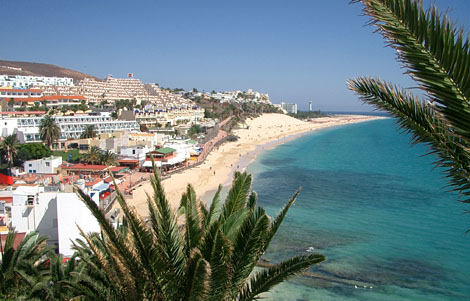 Morro Jable
Morro Jable
Morro Jable is the southernmost resort town of the island, which still at the end of the years 70. XX w. was a little known fishing village, numbering little more than 200 residents. Currently, approx 8 thousand. people, and for tourists (mainly German pensioners) prepared over 16 thousand. beds. Despite the still emerging hotels and apartments, older part of town, at the southern end of the resort, it managed to keep some charm. The beach promenade is the pride of the town, where numerous restaurants and cafes are located.
There are actually no monuments in Morro Jable, however, it is worth going up the hill at the southern end of Playa de las Coloradas – from the terrace of the church Nuestra Seńora del Carmen, which was built there, there are beautiful views. You can then walk along the seaside promenade to the lighthouse, which rises in the protected coastal meadows of Saladar de Jandia.
Cofete and Barlovento Beach
In one of the most beautiful and inaccessible places on the island, many years ago, fishermen were hiding while escaping from compulsory military service. They built several stone houses for their needs, that have survived to this day. However, it is not the settlement that is the biggest attraction of this place, but the views of the golden Playa del Cofete stretching to the horizon (14 km) oraz Barlovento Beach (10 km), surrounded by volcanic hills on one side and azure water on the other. In natural, The villa surprises the almost wild landscape, or rather, a small palace a few hundred meters from Cofete. Willa Winter was designed by the German engineer Gustav Winter in 1946 r.
There are many incredible legends about the mysterious house, it is suspected, that the villa was a secret supply base for German submarines and that after the war, Nazi generals underwent facial plastic surgery there.
From the end of the years 80. XX w. the owner of the residence is a Spanish development company, which is said to be considering opening a small hotel in it.
You can only reach Cofete by your own means of transport, however, it is enough to drive a car at least once 20 km of route, to understand, why not too many tourists come there. The asphalt road leading south of Morro Jable turns into a gravel road after just a few kilometers. Contrary to the opinion of many people, an off-road vehicle is not necessary - the route can be traveled by an ordinary vehicle, you just have to drive slowly and carefully (which is necessary anyway because of the goats wandering along the road). To travel from Morro Jable to Cofete, need after 10 km driving on a gravel road, turn right at the fork at the sign. Continue straight ahead, commute to Punta de Jandia.
Punta de Jandia and Puerto de la Cruz
The gravel road leads practically to the end of the island – from Punta de Jandia, with a lighthouse and the fishing village of Puerto de la Cruz. More and more tourists are coming here, however, this place still accurately describes the word "secluded". Views, that extend from the lighthouse to the harsh landscape of Fuerteventura, are unforgettable. The whole is completed by the panorama of Playa de Cofete, which can be admired from Punta Peserbe, located a few kilometers north, where the gravel road leads from Puerto de la Cruz.
It seems unlikely, but there are several restaurants in the settlement at the end of the world, in which good fish dishes are served. It is worth trying the "fish cauldron" (Galician) in Punta de Jandia and gofio soups (scald). Good food is also served in El Caletón and Tenderete. If anyone wants to stay in this place for longer, can rent Casa Cari, right by the sea.